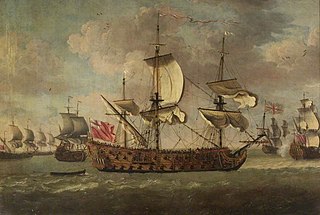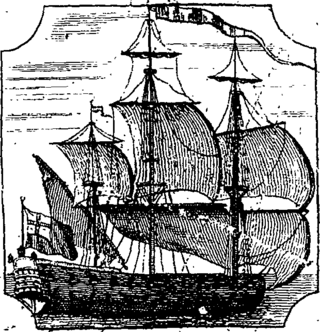HMS Rupert was a 64-gun third rate ship of the line of the Royal Navy, launched at Harwich Dockyard on 26 January 1666 and broken up in 1769.
HMS Greenwich was a 54-gun fourth-rate ship of the line of the Royal Navy, built by Christopher Pett at Woolwich Dockyard and launched in 1666.

HMS Falkland was a 50-gun fourth-rate ship of the line of the Royal Navy, built by Holland of New Castle, New Hampshire, and purchased by the navy in 1696.

HMS Swiftsure was a 70-gun third-rate ship of the line of the Royal Navy, built by Sir Anthony Deane at Harwich, and launched in 1673. By 1685 she had been reduced to a 66-gun ship.
HMS Defiance was a 64-gun third rate ship of the line of the Royal Navy, built by Phineas Pett II at Chatham Dockyard, and launched in 1675.

HMS Oxford was a 54-gun fourth-rate ship of the line of the Royal Navy, built by Francis Baylie in Bristol and launched in June 1674. Her guns comprised twenty-two 24-pounders on the lower deck, with twenty-two large sakers (8-pounders) on the upper deck and ten smaller sakers (5-pounders) on the quarterdeck.
Lyme was a 52-gun third rate Speaker-class frigate built for the navy of the Commonwealth of England at Portsmouth, and launched in 1654.

President was a 38-gun fourth rate frigate of the Royal Navy, originally built for the navy of the Commonwealth of England by Peter Pett I at Deptford Dockyard, and launched in 1650.
HMS Torbay was an 80-gun third rate ship of the line of the Royal Navy, launched at Deptford Dockyard on 16 December 1693. In 1707, she served as flagship of Rear-Admiral of the Blue Sir John Norris and belonged to Admiral Sir Cloudesley Shovell's fleet. She saw action during the unsuccessful Battle of Toulon and was present during the great naval disaster off the Isles of Scilly when Shovell and four of his ships were lost, claiming the lives of nearly 2,000 sailors. Torbay suffered little to no damage and finally managed to reach Portsmouth.

HMS Lancaster was an 80-gun third rate ship of the line of the Royal Navy, launched at Bursledon on 3 April 1694.

HMS Canterbury was a 60-gun fourth-rate ship of the line of the Royal Navy, launched at Deptford on 18 December 1693.

HMS Windsor was a 60-gun fourth rate ship of the line of the Royal Navy, launched at Deptford on 31 October 1695.

HMS Orford was a 70-gun third-rate ship of the line of the Royal Navy, launched at Deptford in 1698. She carried twenty-two 24-pounder guns and four (18-pounder) culverins on the lower deck; twenty-six 12-pounder guns on the upper deck; fourteen (5-pounder) sakers on the quarterdeck and forecastle; and four 3-pounder guns on the poop or roundhouse.

HMS Weymouth was a 50-gun fourth rate ship of the line of the Royal Navy, launched at Portsmouth Dockyard on 8 August 1693. She was one of two 50-gun ships ordered on 15 August 1690 to be built by Master Shipwright William Stigant at Portsmouth Dockyard. However, unlike the Norwich, the Weymouth was delayed until 1693 and - instead of the 123 ft length originally specified - was lengthened to 132 ft 4 in, thus becoming the prototype for the 1693 batch ordered with a design extended to some 130 ft.

HMS Mary was a 60-gun fourth rate ship of the line of the Royal Navy, built at Chatham Dockyard and launched on 12 May 1704.
HMS Romney was a 50-gun fourth rate ship of the line of the Royal Navy, built by Sir Joseph Allin to the 1706 Establishment at Deptford Dockyard, and launched on 2 December 1708.
HMS Sunderland was a 60-gun fourth rate ship of the line of the Royal Navy, built to the 1719 Establishment at Chatham Dockyard, and launched on 30 April 1724.

HMS Deptford was a 60-gun fourth rate ship of the line of the Royal Navy, built to the dimensions of the 1719 Establishment at Deptford Dockyard, and launched on 22 August 1732.

HMS Eagle was a 58-gun fourth rate ship of the line of the Royal Navy built at King's Yard in Harwich by John Barnard and launched in 1745.
HMS Preston was a 50-gun fourth rate ship of the line of the Royal Navy, built at Deptford Dockyard by Adam Hayes to the draught specified in the 1745 Establishment, and launched on 7 February 1757.











